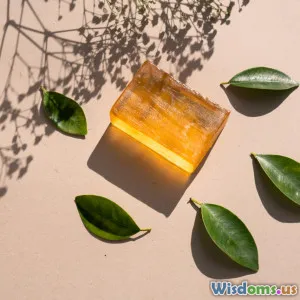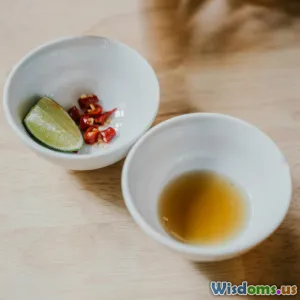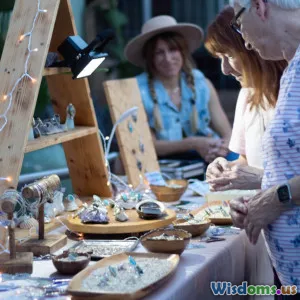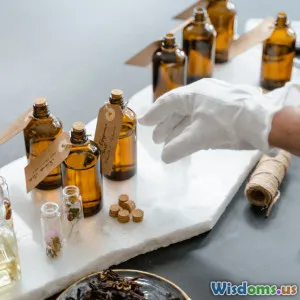
Is Handmade Soap Really Better? Surprising Facts You Did Not Expect
9 min read Explore the surprising benefits and truths about handmade soap beyond common beliefs. (0 Reviews)
Is Handmade Soap Really Better? Surprising Facts You Did Not Expect
Soap has been part of human history for millennia, but the rise of handmade soap has sparked a passionate debate: Is handmade soap really better than store-bought alternatives? At first glance, the glow of artisan soap bars—wrapped in natural packaging and infused with botanical scents—appears it could be a purer, more skin-friendly choice. But the truth behind handmade soap’s superiority is more complex and fascinating than you might expect.
What Defines Handmade Soap?
Before we delve into comparisons, it's important to establish what handmade soap really is. Unlike commercial, mass-produced soaps, handmade soap is typically crafted in small batches, often using traditional methods like cold or hot process saponification. This involves combining fats and oils with a lye solution, allowing the chemical reaction to produce soap and glycerin naturally within the bar.
In contrast, many commercial soaps are actually detergents — synthetic compounds created for cleaning — and oftentimes manufactured separately from glycerin, which is removed and sold as a byproduct.
1. The Ingredient Advantage: Natural, But Not Always Safer
One of the largest perceived benefits of handmade soap is its ingredient list. Handmade soaps generally contain raw vegetable oils (like olive, coconut, or shea butter), essential oils for fragrance, and natural colourants. This appeals to those looking to avoid synthetic fragrances and harsh chemicals found in many commercial soaps.
Skin Friendliness and Sensitivities
For individuals with sensitive skin or eczema, handmade soap can be gentler because it may lack harsh synthetic detergents, preservatives, or irritants. For example, a study published in the Journal of Dermatology found that some synthetic detergents used in mainstream soaps can strip natural oils excessively, exacerbating dry skin conditions.
However, it’s critical to note that ‘natural’ does not guarantee hypoallergenic. Essential oils and botanical extracts can provoke allergic reactions in some people. Lavender or citrus oils, though natural, are common allergens. Furthermore, handmade soap often contains lye residues if not crafted properly, which could irritate the skin.
Transparency and Customization
Handmade soap makers often pride themselves on transparency, listing every ingredient used. This allows consumers to tailor their choices to skin needs and ethical concerns (such as vegan or cruelty-free products). For example, a soap maker might formulate with coconut oil to boost cleansing power but pair it with shea butter to increase moisturization, carefully balancing the final product.
2. Environmental Footprint: Sustainability That Counts
Beyond personal care, handmade soap often wins the environmental competition against commercial alternatives.
Packaging and Waste Reduction
Handmade soaps are usually sold with minimal, biodegradable packaging—paper wraps or compostable boxes—unlike plastic bottles or multi-layered packaging common in commercial soaps. This actively reduces plastic waste, which aligns with growing consumer demands for sustainable products.
Ingredients Source and Biodegradability
Handmade soaps rely on natural oils and plant-based components that are biodegradable. Conversely, synthetic detergents found in many commercial options may persist longer in the environment and pollute waterways.
For example, conventional soaps often feature palm oil, linked to deforestation. Handmade crafters are increasingly turning to sustainable sourcing such as fair-trade or recycled ingredients.
Energy Consumption Insights
Interestingly, while handmade soap crafting uses less industrial energy due to small batch production, sourcing sustainable oils and ethical ingredients can sometimes have a higher environmental cost. The real environmental impact depends on the maker’s practices and ingredient supply chain transparency.
3. Performance and Longevity: Does Handmade Soap Lather and Last?
A widespread misconception is that handmade soap doesn’t lather as well or isn’t as effective. This often stems from differences in formulations.
Glycerin Rich Bar
Handmade soaps retain glycerin, the moisturizing byproduct of saponification, which commercial soaps sometimes remove for use in lotions. This glycerin content can make handmade soap gentler and moisturizing, but also sometimes softer and faster to dissolve if stored improperly.
The Science of Lather and Hardness
Soap hardness and longevity depend on the blend of oils and curing time. Coconut oil content yields strong cleansing and fluffy lather; olive oil provides mildness but less froth. A well-formulated handmade soap that cures for 4-6 weeks typically lasts longer and performs comparably or better than store-bought bar soaps.
Handling and Storage Tips
To maximize lifespan and maintain lather quality, handmade soaps should be kept dry between uses—using well-drained soap dishes helps prevent sogginess.
4. Economic and Ethical Considerations
Shopping handmade often means supporting small artisans or local businesses, contributing to communities and economies in a direct way.
Supporting Artisans and Craftsmanship
Many handmade soap sellers source or cultivate ingredients themselves, offering opportunity for consumer education about skincare and ingredient origins. The personalized connection between buyer and maker often elevates perceived value and satisfaction.
Price Tag Realities
Handmade soaps frequently cost more per bar than mass market options due to manual labor, premium ingredients, and small-scale production. However, many buyers appreciate this for the quality, ethical sourcing, and charitable impacts.
Conclusion: Takeaways and What It Means for You
Is handmade soap really better? The answer isn’t black-and-white but a nuanced mix of benefits:
- Ingredients: Often more natural and transparent, but natural doesn’t always mean hypoallergenic.
- Environment: Generally more sustainable in packaging and biodegradability but depends on sourcing practices.
- Performance: Can provide better moisturizing and comparable effectiveness if crafted well.
- Ethics and Economy: Supports artisans and small business with higher consumer engagement.
If your priority is skin sensitivity, environmental responsibility, or supporting small businesses, handmade soap is likely a worthwhile switch. For those prioritizing cost or intensive cleaning power, some commercial options might fit better.
Ultimately, the best soap depends on your values and skin needs. And with a bit of experimentation, handmade soap may well surprise you—not only in how it feels on your skin but in the story behind every bar.
Further Action
If intrigued, consider trying a small batch from a trusted local soap maker or even making your own. DIY soap crafting is accessible and educational, connecting you with the craft, ingredients, and benefits firsthand.
References:
- Journal of Dermatology: Effects of synthetic detergents on skin barrier
- Environmental Science & Technology: Biodegradability studies of soap components
- Artisanal Soap Makers' Pledge for Sustainable Sourcing
Author's note: This article brings to light the complexity and depth behind what seems like a simple bar of soap, hoping to empower readers to make better-informed decisions about their skincare and environment.
Rate the Post
User Reviews
Popular Posts





















